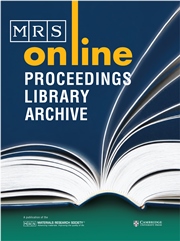No CrossRef data available.
Article contents
Dynamics of Graphene Nanodrums
Published online by Cambridge University Press: 02 March 2011
Abstract
Recently, it was proposed that graphene sheets deposited on silicon oxide can act as impermeable atomic membranes to standard gases, such as helium, argon, and nitrogen. It is assumed that graphene membrane is clamped over the surface due only to van der Waals forces. The leakage mechanism can be experimentally addressed only indirectly. In this work we have carried out molecular dynamics simulations to study this problem. We have considered nano-containers composed of a chamber of silicon oxide filled with gas and sealed by single and multi-layer graphene membranes. The obtained results are in good qualitative agreement with the experimental data. We observed that the graphene membranes remain attached to the substrate for pressure values up to two times the largest value experimentally investigated. We did not observe any gas leakage through the membrane/substrate interface until the critical limit is reached and then a sudden membrane detachment occurs.
Keywords
Information
- Type
- Research Article
- Information
- MRS Online Proceedings Library (OPL) , Volume 1284: Symposium C – Fundamentals of Low-Dimensional Carbon Nanomaterials , 2011 , mrsf10-1284-c14-03
- Copyright
- Copyright © Materials Research Society 2011

